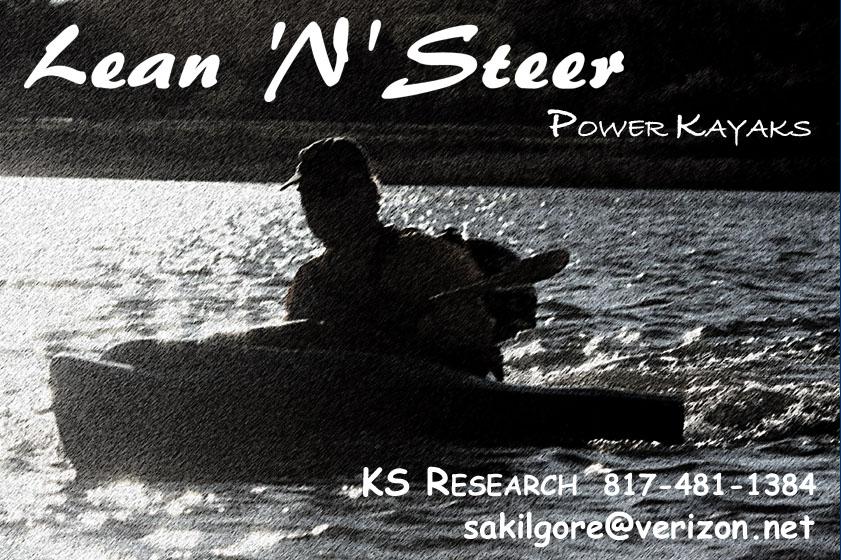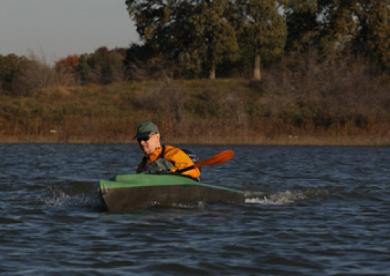 |
||
LEAN 'N' STEER® Power Kayaks Truly For One Person - One Boat |
||||||||||||||
 |
||
 |
||
Construction - Anatomy of a Hull Aerospace Grade Composites With A Proprietary Resin Used For A Strong Hull |
||
 |
||||||
Tough, Light Hull *Sophisticated Very High Impact Aircraft Grade Fiberglass Epoxy Composite Hull For Long Service Life. Our Proprietary Epoxy Resin System Has Gone Through Over 15 Years Of Structural and Environmental Testing. *Heat And UV Resistant Tough Composite Materials Do Not Deform In The Sun Like Rotomolded Hulls. *Repairable – While Damage Is Unlikely, This Material Is Easily Repairable. Non-Glossy Finish Also Eases Repair If Necessary. *Built As A Power Boat, With A Durable, High Strength Cockpit Floor, Transom, And Motor Mount Structurally Designed To Operate With Gas Or Electric Outboard Engines – NOT Just A Kayak or Canoe With A Motor Mount Bolted On As an Afterthought On A Hull Designed For Human Power. |
||||||
Early Production Boat Shown (November 2009) |
||||||
*Unique Hull Design Results In A Quick Plane At Low Speed, And An Even Keel With the Water At All Speeds, From Unloaded Rest To Loaded Full Speed. |
||||||
UGLY, SOPHISTICATED, AND TOUGH OK, I admit it. These boats are not made as contest winning beauties. There are no stunning Metalflake gel coated finishes. And they are NOT made of beautiful, but delicate wood. NO, these boats are made as utility boats, boats made to last a lifetime. These boats are made of a proprietary high impact epoxy resin and very tight woven S glass type Fiberglass. Carbon fiber reinforcement and Coremat are used in selected areas. All parts are hand laid and vacuum molded in double sided molds. Hull thickness and strength vary throughout the hull to provide high stiffness and thickness where needed, such as in the bow, floor and transom, and thinner structure in areas where more resilience is desirable. By careful design of the selection and layup of the fabrics, the hull acts as a stiff frame with shock absorbing characteristics. This provides a rigid platform for the motor and efficient forward motion, while allowing the boat to ride smoothly over chop without pounding. They are made to stand many years of dragging onto or running up on gravel shorelines. Occasional hits and bouncing off rocks, logs, or posts is very unlikely, OK, VERY, very unlikely to do any significant damage to these boats. They will pick up scratches in use, but these are cosmetic only. One of these boats can also bake on top of your car for years in the hot sun and never warp. I know, we've been purposefully abusing very light kayak hulls (and other products) made from my formula for nearly 20 years, and they are still holding up nicely. Fiberglass generally gets a bad wrap in most people's minds because of the damage seen on low or moderate grade fiberglass reinforced products. Most of us have seen a badly damaged, delaminated, feathering and flaking hull or car body that was involved in some type of accident. Our materials cannot be confused with even other high grade epoxy resins. This is a very tough resin. And fiberglass cloth itself is very strong, tough, impact resistant, and light. The only problem with fiberglass is the resins used with it are generally too brittle, and exhibit poor impact strength. And should you damage it? Drop it off a cliff?! Have it fly off the top of your car into a bridge abutment at 80 mph?! Every part of the boat is designed and constructed to be repairable by anyone of even very average skills. The motor mount, motor mount clamp pad, seat and seat frame, and Spray skirt cowling are all easily removable for repair or replacement. Seats are commonly available. Most of the hardware can usually be matched up and replaced at a good hardware store or marine supply. The lower hull itself is coated with a fine texture that is used to make it very easy to match in case of repair. The upper hull receives a heavier texture that is also designed to be easy to repair. Simple repair kits to match hull materials are available from the factory. Or boats can be sent back to the factory for repair. FIELD REPAIRABLE Temporary field repairs can be handled with that handyman’s best friend, a good quality duct tape. I say temporary, but several years ago, I damaged two areas on a 28 lb fiberglass/ epoxy kayak hull that I built as a test of the materials. (Small sledgehammers are good for this.) I repaired a lower hull area that I cracked with vinyl tape. And I left an exposed cracked cockpit edge (no cowling was installed) unrepaired to see if it would tear and delaminate. I left these parts as is for over three years before repairing them. The damage did not spread and the hull did not leak. Please note that damage severe enough to make repair impossible or unrealistic would probably also cause serious injury or death to any occupant in the boat. STAINLESS STEEL HARDWARE All metal hardware on the boat is marine grade stainless steel or brass. Plastic hardware is used for such items as the drains. |
||
 |
||
CONSTRUCTION When someone mentions fiberglass, the normal reaction is to think, "Ohh, That's going to be strong, but isn't that also going to be brittle?" Most of us have seen some fiberglass or composite product that has failed. Whether it was a car, a boat, a swimming pool, or a high tech bicycle or airplane part, many of us have seen the brittle frayed fibers and damage that "stars", or delaminates out from the original impact. But it doesn't have to be that way. |
||
The Lean 'N' Steer ® Prototype in Action (Taken documenting test runs in October 2008) |
||
The Problems of Roto-Molded Boats Most inexpensive to moderate priced kayak and kayak-like boats today are made of polypropylene using the rotational molding method. These are very cheap to make, but have significant disadvantages. First, they can easily warp in the hot sun. This deformation is due to the relatively low temperatures they have to be molded at. Changes to the hull shape by strapping one of these boats on a car top carrier in the hot sun can significantly affect the hulls performance in the water. Second, they are very flexible. Only with additional reinforcement or ribs are they stiff enough to move efficiently through the water. This adds weight, frequently, a lot of weight. A composite boat can easily be constructed today of 2/3rds to as little of half the weight of any rotationally molded boat, with greater strength, and performance. Third, polypropylene is difficult or impossible to repair, so significant damage makes the boat a throwaway. Not exactly good for the environment, unless properly recycled. Even then, it is a waste. A rotationally molded polypropylene hull compared to a good quality composite hull is to boats what a department store bike is to a high quality touring or racing bike frame. And yet people will pay thousands of $$ extra for bicycle frames capable of delivering maybe a 5-10% improvement in performance over bikes costing only a few hundred dollars. Yet a standard recreational kayak hull molded of a stiff, light, high quality or aerospace grade cloth composite can be paddled as much as 25-30% faster than the same design roto molded. But why? Is it the light weight? No, lighter weight really does help a little, but it is really the same reason the more exotic bicycle frame can help performance. It is because a stiffer, stronger hull allows more energy from the paddler to drive the boat forward, rather than be wasted fighting the water. The same attributes are desirable in a powerboat hull, with one exception. An ability to ride comfortably over choppy water without losing performance can be obtained in the design and layup of a composite hull easier and more consistently than is possible with rotational molding. Still another significant advantage to cloth and epoxy composite construction is the fact that a hull can be designed that needs few or no interior ribs. Epoxy resins are the strongest of the three general types of catalyst based resin systems used in composite construction today. The epoxy resin system I developed that is used in this boat was developed to improve or eliminate the impact resistance problems of composite structures. This resin produces composites of very high impact resistance. Even when an impact is powerful enough to damage the hull, impact damage is limited to the area of impact with no delamination past the impact site. Damage doesn't have a tendency to spread. This makes repairs much easier. |
||
The fiberglass and carbon fiber cloth used to make high quality composite structures is actually very strong, soft, and flexible. Fiberglass cloth, for instance, is sometimes used to make very soft shimmering drapes, due to its fire resistance. The fault isn't the cloth, known in composites as the reinforcement. It is the resin, known as the matrix. Many of the resins can be very brittle, particularly polyester resins, which are also the cheapest resins. For example, fiberglass and carbon fiber are used to reinforce some thermoplastics, most commonly Nylon®. Yet the fiberglass does not make the plastic brittle. It just makes it stronger. Gee. So why not make a boat out of reinforced Nylon®? For a variety technical reasons, that would neither be possible, nor would it possibly even be desirable. It would also be very expensive as Nylon® would be injection molded. Fiberglass reinforced ABS is a possibility, but has a number of disadvantages, including heat deformation (warping), and lower strength than even traditional fiberglass. It is also difficult to repair. ABS is normally molded by vacuum forming sheets of plastic, which means any stiffness and strength comes from forming ribs and the thickness of the plastic, which also varies as it stretches into the mold. Fortunately, vacuum forming can use sheet plastics that melt at higher temperatures than rotational molding. So vacuum forming can produce a pretty good, inexpensive hull, yet with significant disadvantages. This brings us to a weaker, but far more common method for making a small boat. |
||
Lean 'N' Steer Powered Kayak Power Kayak Kayaks, Lean and Steer Lean N Steer LeanNSteer, Motor Kayak MotorYak Motor Yak Motor Kayak Fiberglass Kayak, Recreational Kayak Outboard Motor Kayak Kayak powered by Honda, Yamaha, Suzuki, Tohatsu, Nissan, Mercury Outboard, 2 hp Kayak 2 hp Powered Kayak, Motorized Kayak, Smallest Powerboat, Lightest Powerboat |
||